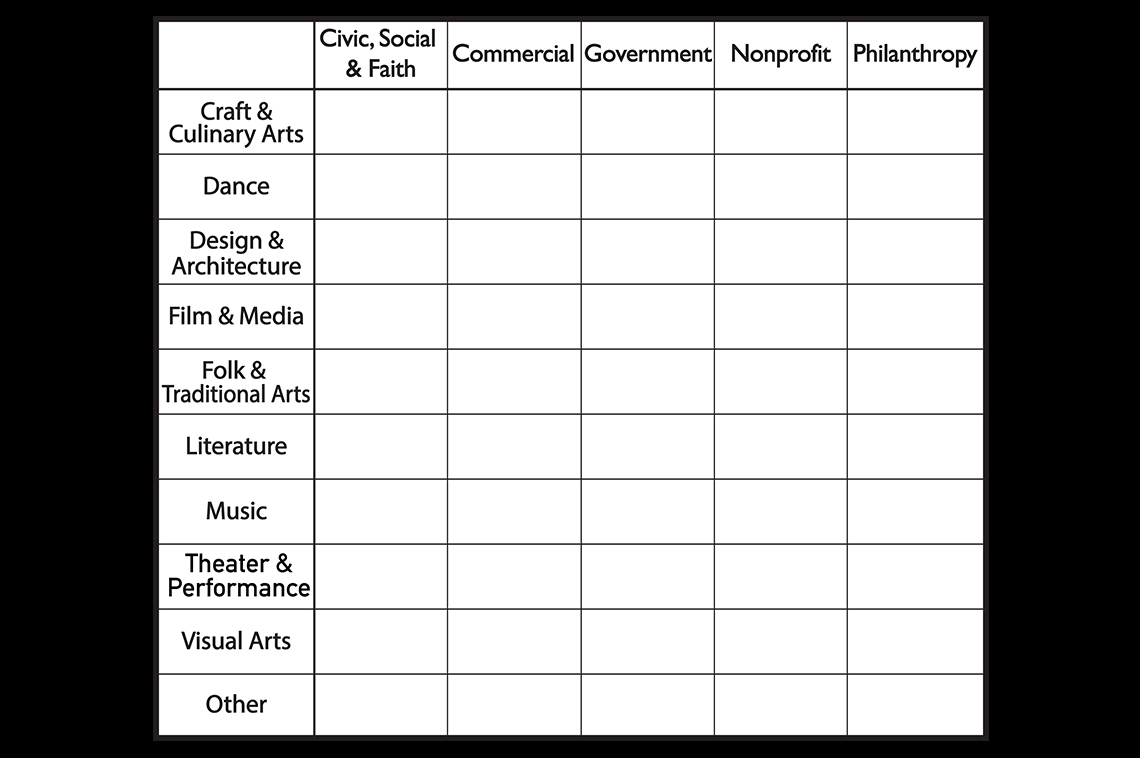
Earlier this year we tipped our hand about sharing a tool that lays out how the arts and culture sector organizes itself. The Community Development Matrix has proved valuable in helping us analyze the diversity of our work by sector and stakeholder type, but what about arts and culture? If our goal is to integrate the arts into community planning and development, we should bring he same level of rigor to each domain.
This framework offers us a way to keep tabs on the arts disciplines and types of practitioners that comprise the creative placemaking field. The list of disciplines in the left-hand column should be relatively familiar to those who are familiar with our National Grants Program, and there are a couple of nuances to note.
In sharing this with some of our partners we were often asked, “why group craft and culinary arts together, and what if my craft is traditional?” We think of craft and culinary arts as a set of practices based in materials, while folk & traditional arts are based in a heritage. There is bound to be overlap among many of these categories, most notably in situations where work is intentionally interdisciplinary, but this at least gives us a solid starting point.
A few disciplines were difficult to categorize. For example, storytelling could leverage dance, literature, music, and theater simultaneously. In contrast to its community development counterpart, we thought this matrix should have an “Other” category to help capture those situations where categorization would prove unhelpful.
Turning to the top row, you’ll notice that the types of stakeholders mirror those in the community development matrix. We’re looking to capture the entire arts and culture sector; which includes artists, organizations, and supporters alike. So church choirs, Broadway productions, public art, afterschool programs, and private donors would each correspond to one of the stakeholder types respectively.
We also think it’s important to consider how individual artists’ work might fit into these categories. A church choir soloist, chorus member in a hit musical, sculptor working on a bus station installation, middle school teaching artist, or painter who regularly donates her work to charity auctions would each correspond to a stakeholder type.
We look forward to the insight that this matrix will provide for our work to-date and the value it could create for the future. For example, by looking at the arts and community development matrices in tandem we may find trends that point toward strong relationships between individual sectors and disciplines. Hypothetically speaking, this could help show that craft & culinary arts have a strong relationship with workforce development and less of a relationship with transportation. Our hope is that this kind of analysis will help us both better understand the creative placemaking field and focus our efforts to integrate the arts into community development across the country.
What do you think? Is this something you’d find useful to your work, or does the idea of this kind of categorization bring other thoughts to mind? As always we look forward to your feedback via the comments section below. Please note you do have to be logged in, in order to leave a comment.





